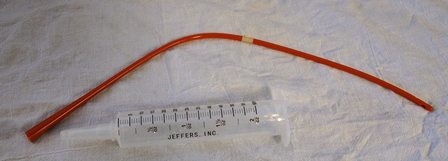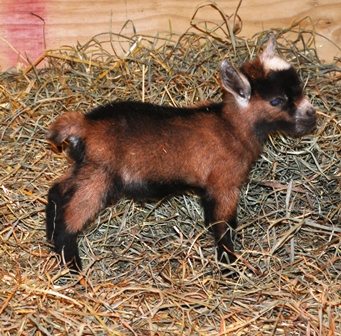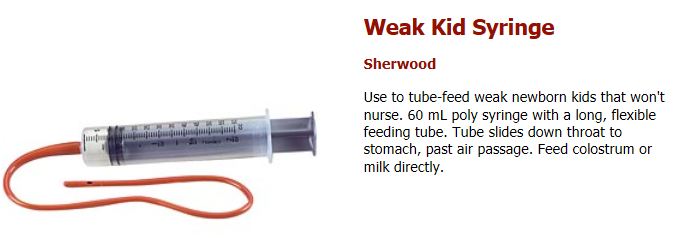We’d been told at a goat class that if you raise goats, you’ll learn how to tube feed a weak kid – and unfortunately we’re now experienced. At some point Saturday evening or Sunday morning, Jewel Box decided to reject one of her kids, the one we named Dillinger. Saturday was a cold night (hard frost) and by Sunday morning when we realized she wasn’t letting him nurse, he was weak and cold. So, we brought him in, warmed him up, and tried to get him to nurse; but he wouldn’t do that and he wouldn’t take a bottle. It was shocking to see how quickly he went from a bouncing to limp baby.
Fortunately, in preparation for kidding (see Kidding Season Supplies), I’d purchased a couple of tube feeding kits (the kits contain a weak kid syringe and feeding tube – see photo above) – just in case. Although it looks difficult and painful, it’s better to tube feed a kid than to try feeding with a syringe. Feeding with a syringe makes it too easy for the kid to aspirate fluid into its lungs, and can cause it to choke to death or get pneumonia.
We followed the directions for tube feeding given in the book “Goat Health Care” by Cheryl Smith which I previously recommended (see Recommended Reading for Nigerian Goat Owners) and we’d also seen the process demonstrated (although not on a live kid) at a goat class. Two people are really necessary (the kid will struggle and you need to be gentle); and the feeding tube, syringe, milk (or colostrum if it’ a newborn), and some warm water are all the equipment that’s required. First, it’s necessary to figure out how far to put the tube in to get to the kid’s stomach. Do this by measuring from the kid’s nose to his ear, and from his ear to the floor of his chest, and add the two together. Mark this distance on the tube with a piece of tape – this is how far you’ll need to insert the tube. For Dillinger it was 7″ (see marked tube below) – seemed like an awful lot for a little kid.
Then, holding the kid sitting up (not laying on its side which makes it more difficult to get the tube in), dip the end of the tube in some warm water, and insert the tube over the tongue and into the throat until you’ve reached the length you marked with tape. The trick is to get the tube into the stomach rather than the lungs; tube feeding into the lungs will likely cause pneumonia and death – it may take several tries to get the tube into the stomach. One method to tell whether you’re in the lungs is to listen for noise, if you hear any breathing or crackling then you’re in the lungs and need to start over. Another is to put the other end of the tube in a glass of water and see if any bubbles form – if they do you’re in the lungs and need to try again. The water-glass was the method we used, and the first time we got bubbles – so we tried again and were successful the next time. Proceed with feeding only when you’re sure the tube is in the stomach and not in the lungs.
Once you’re sure that the tube is in the stomach, attach the other end to the feeding syringe filled with a bit of water and make sure the water flows into the stomach. Hold the syringe above the kids head, and let gravity push the water into the kid’s stomach – you shouldn’t use the inner part of the syringe to force the fluid – we removed the inner part of the syringe because it seemed to create a vacuum which prevented the flow of fluid by gravity). Once you’re sure that the fluid is flowing into the stomach, add the recommended amount of whatever you’re feeding (2 ounces of milk from Jewel Box in our case).
After the fluid you’re feeding is in, add a little more water to the syringe – this helps to prevent aspiration of milk as you’re removing the tube. Then take the syringe off the end of the tube, cover the end of the tube with your finger, and slowly remove it from the kid’s stomach. The whole procedure is likely to make the team performing it a nervous wreck the first several times around; however, it’s necessary for the kid is to have a chance at survival.
We successfully tube fed Dillinger, he went to sleep, and upon waking we tried to get him to take a bottle. He still wouldn’t do that, so we put Jewel Box up on the stanchion and held Dillinger up to nurse. He finally did nurse so we continued to put Jewel on the stanchion and worked on getting him to bottle feed throughout the day. By Sunday evening, Dillinger seemed to be out of danger and acting spunky again – it’s amazing how fast they bounce back too!

Val M. says
I just tried this and my goat died almost immediately. She had become chilled during the night so we brought her in the house and got her temp back up to 103.2 but she would not even try to eat. We waited an hour and then tubed her. We thought we had the tube in the stomach- we did the water glass test and got no bubbles.
We got some milk in her and she died almost immediately- what a heartbreak. We don’t know if we killed her by tubing or if we waited too long to try or if she was never going to make it anyway.
Lesa says
Hi Val, I’m so sorry you lost her 🙁 It’s always hard when that happens – all we can do is try to do the best we know how.
LindaG says
Glad to hear it.
Seems like all kids bounce back, don’t they?
Have a good day!
Jenn Andersen says
Wow~ Great work! Thank you for the detailed instruction too. I wonder if I could use this on puppies that won’t eat as well. I used to do dog rescue and often had sick puppies to deal with. None of the vets ever recommended tube feeding, but I think it would have been safer than feeding with the syringe as they recommended.
Glad Dillinger is okay!
Lesa says
Jenn, my sister-in-law is a Vet Tech, and she says that’s what they use for puppies and kittens when they can’t get them to eat, as it is safer than a syringe.